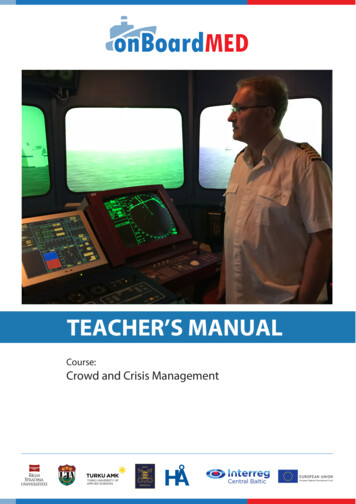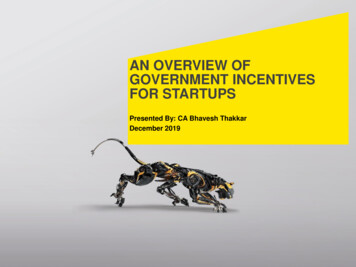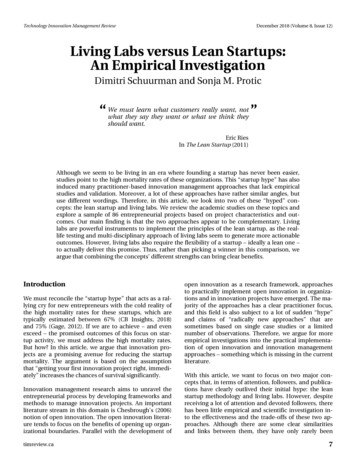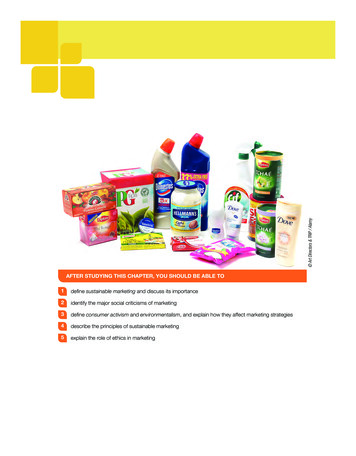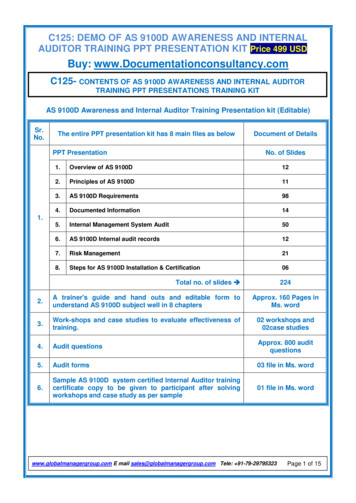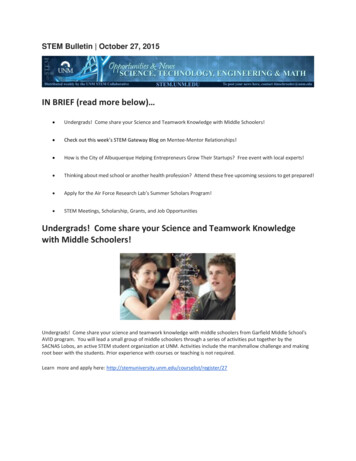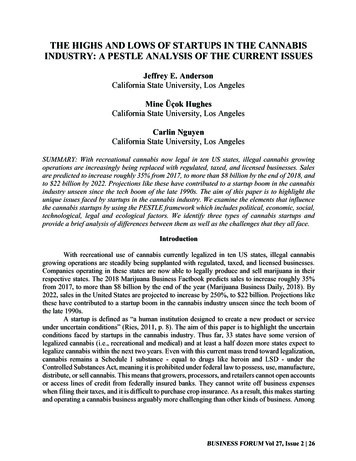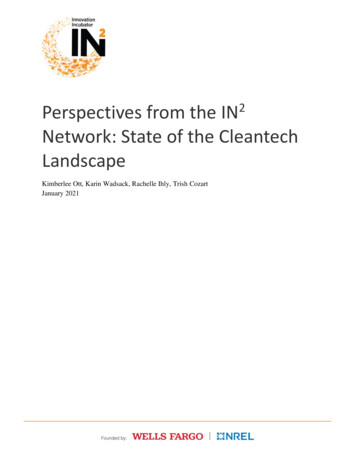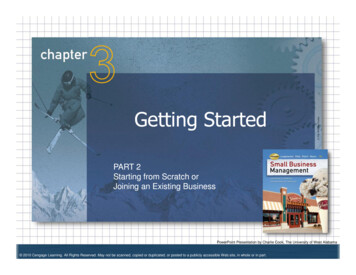
Transcription
Getting StartedPART 2Starting from Scratch orJoining an Existing BusinessPowerPoint Presentation by Charlie Cook, The University of West Alabama 2010 Cengage Learning. All Rights Reserved. May not be scanned, copied or duplicated, or posted to a publicly accessible Web site, in whole or in part.
Entrepreneurial OpportunitiesOpportunityStarting a businessBuying a businessFranchised businessFamily businessLevel of RiskHigh riskMedium riskMedium riskVariable risk3–3
Starting a business – Anticipation/ExcitementWhat type of roller coaster do we want?We get our expectations from others . . .Perhaps less risk?A kiddie coasterOR, A thrill ride (higher risk)?Its an emotional issue –Sometimes we get out ofline at the last minute . . .3–4
Identifying Startup IdeasRecognitionIdentify new products/ servicesAlertnessReadiness to actExisting (unnoticed) opportunityInvestmentsClear (important) needsProducts customers knowProducts customers can afford3–5
Startup Ideas – Film (4 min)Have you ever thought of a start-up on your own?From where did you get your idea?Example: Existing Technology led tonew productsStart-up Static: How hard could it be?PriceEmployeesProductsMarketingAdvertisingTwo people can start the same type of firm withdrastically different results – its in the details3–7
Kinds of Startup Ideas – Which is yours? Type A New Market Existing productNot available in their market Type B New Technology New ideasNew technologyNew product Type C New Benefit Improved productPerform old function in a new and improved way– Most common source of business start-ups - exam3–10
New Product Ideas for Small Business Startups – on exam3–12
Innovative Thinking – Apply to Business Ideas1. Borrow ideas from existing products and services or other industries.2. Combine two businesses into one to create a market opening.3. Begin with a problem in mind.4. Recognize a hot trend and ride the wave.5. Explore ways to improve a product or service’s function.6. Think of how to streamline a customer’s activities.7. Adapt a product or service to meet customer needs in different ways.8. Imagine how market for a product or service could be expanded.9. Use “green” technologies to make the product or service moreenvironmentally friendly10. Keep an eye on new technologies.Think of one (1) Innovative New Business Idea now for #53–13
Ten Rules for Entrepreneur SuccessBook: Finding Fertile Ground: Identifying ExtraordinaryOpportunities for New Ventures by Scott Shane (Hand Out)#1 predictor of new business failure the industry inwhich the firm is founded Retail businesses and restaurants have extremely high failure rates1.Select the right industry2.Identify valuable opportunities3.Manage technological transitions4.Identify and satisfy real market needs5.Understand customer adoption6.Exploit established company weaknesses7.Manage intellectual property8.Create barriers to imitation9.Choose the right organizational form10.Manage risk and uncertainty3–15
The Difficult Becomes EASYLearn to make the difficult easy Anything we do is much more difficult the 1st time we do it Gets progressively easier the more we do itExample:Walk 15 miles It might be hard the 1st time we walk this far Do it everyday, incrementally building, and it becomes easier to doIt takes our body/mind 2 weeks to Make it EasyMorale of the story: Do it EVERYDAY itsExample: Do 1 or 2 Innovative Thinking Exercise items a daye.g., consider two items each day (in rotation)3–16
Startup Ideas – Film (4 min)Joseph’s Sugar-free Cookies1. How does the company continue to grow/innovate (what makes it different)?2. Where did his startup idea come from?Josephs Sugar Free Cookies Start Up3–20
SWOT AnalysisModified plete in 5 days:Day 1: OpportunitiesDay 2: ThreatsDay 3: StrengthsDay 4: WeaknessesDay 5: Analysis80% on S- O20% on W- T3–22
SWOT – Putting it all together sessments/SWOT/SWOT.aspI developed an Interactive SWOT ToolFrom my home page,1. Click on “Entrepreneurship Resources”2. Scroll to bottom of page3. Click on “SWOT Analysis”3–23
Practical SWOT FormatExternal Environment Social, Economic, Political,Technological, Competitive TrendsWhat do these “uncontrollables” look like?Lets look at Opportunities first:1.What are some new and emerging technologies that can help yourbusiness (explain)?2.Which portion of the economy is growing that can help yourbusiness (industries)?3.What are interest rate/inflation trends and how might yourbusiness gain by them?4.What are new government regulations (certification requirements)that may benefit your particular business?5.What are current demographic trends (income levels,employment) and how might they help your particular business?3–24
Practical SWOT FormatExternal Environment Social, Economic, Political,Technological, Competitive TrendsWhat do these “uncontrollables” look like?Lets look at Threats now:1.What are some new and emerging technologies that can hurt yourbusiness (explain)?2.Which portion of the economy is shrinking/contracting that canhurt your business (industries)?3.What are interest rate/inflation trends and how might yourbusiness get hurt by them?4.What are new government regulations (certification requirements)that may harm your particular business?5.What are current demographic trends (income levels,employment) and how might they hurt your particular business?3–25
Practical SWOT FormatCSF Critical Success Factors – also called KSIWhat must we do, and do well, to survive and thrivein this business?Lets look at Strengths now:1.What do you do well (that you must do well) in order tosurvive and thrive in your business?How do you measure each of these skills (if not currentlymeasuring, how will you measure them)?2.Describe the types of customers you match the best(the ones you can service the best)?3.With which vendors do you have the best relationship?4.Which results, that you measure each month, wouldyou consider to be your greatest strengths?3–26
Practical SWOT FormatCSF Critical Success FactorsWhat must we do, and do well, to survive and thrivein this business?Lets look at Weaknesses now:1.What do you NOT do well (but you must do well) in order tosurvive and thrive in your business?How do you measure each of these skills (if not currently measuring,how will you measure them)?2.Describe the types of customers you match the least (the onesyou can least service properly)?3.With which vendors should you have a strong relationship, butdon’t?4.Which results, that you measure each month, would you considerto be your greatest weaknesses?3–27
SWOT – Putting it all together (example)An example from my company3–28
SWOT – Putting it all together (example)An example from my company3–29
Feasibility – Will Cover Details w/ Business Plans Feasibility Analysis A preliminary assessment of a business idea thatgauges whether or not the venture envisioned is likelyto succeed Fatal Flaws A circumstance or development that alone couldrender a new business unsuccessful Market potential: acceptance, accessibility, growth, and sizePower of competitorsStrength of competitive advantageStartup costsManagement capability3–30
Release Form for BUSM 66 ProjectPlease complete thetop of the Release FormPlease sign at thebottom of the formAND sign on thereverse side
Entrepreneur Interview –ProjectHandout on Entrepreneur Interview Project Review the steps for project completion (first page) Sign “Release Form” Access files for project CourPage.htmEntrepreneur Interview Instructions (txt) (Right click and "Save Target As .")Entrepreneur Interview On-Line Form Work on/ edit your content (paper then txt file) Complete the project by entering into on-line form3–32
What type of roller coaster do we want? We get our expectations from others . . . Perhaps less risk? A kiddie coaster OR, A thrill ride (higher risk)? Its an emotional issu
